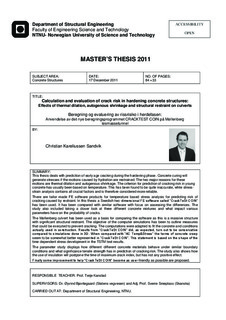| dc.contributor.advisor | Kanstad, Terje | |
| dc.contributor.author | Sandvik, Christian Kareliussen | |
| dc.date.accessioned | 2016-10-12T08:15:20Z | |
| dc.date.available | 2016-10-12T08:15:20Z | |
| dc.date.issued | 2011 | |
| dc.identifier.uri | http://hdl.handle.net/11250/2414411 | |
| dc.description.abstract | This thesis deals with prediction of early age cracking during the hardening phase. Concrete
curing will generate stresses if the motions caused by hydration are restrained. The two major
reasons for these motions are thermal dilation and autogenous shrinkage. The criterion for
prediction of cracking risk in young concrete has usually been based on temperature. This has
been found to be quite inaccurate, while stress-strain analysis contains all crucial factors and is
therefore considered more reliable.
There are tailor made FE software products for temperature based stress analysis for predicting
risk of cracking caused by restraint. In this thesis a Swedish two-dimensional FE software called
"CrackTeSt COIN" has been used. It has been compared with similar software with focus on
assessing the di erences. The study also included taking a closer look at three di erent concrete
mixtures and what impact various parameters have on the probability of cracks.
The M llenberg culvert has been used as a basis for comparing the software as this is a massive
structure with signi cant structural restraint. The objective of the computer simulations has
been to outline measures that could be executed to prevent cracking. The computations were
adapted to t the concrete and conditions actually used in construction. Results from "CrackTeSt COIN" did, as expected, turn out to be conservative compared to simulations done in 3D. When
compared with "4C Temp&Stress" the terms of concrete creep seem to be somewhat better
represented in "CrackTeSt COIN". This statement is based on the shape of the time dependent
stress development in the TSTM test results.
The parameter study displays how di erent di erent concrete materials behave under similar
boundary conditions and what signi cance tensile strength has in prediction of cracking risk.
The study also shows how the use of insulation will postpone the time of maximum crack index,
but has not any positive e ect.
Finally some improvement to help "CrackTeSt COIN" become as user-friendly as possible are
proposed. | nb_NO |
| dc.language.iso | eng | nb_NO |
| dc.publisher | NTNU | nb_NO |
| dc.title | Calculation and evaluation of crack risk in hardening concrete structures: Effects of thermal dilation, autogenous shrinkage and structural restraint on culverts | nb_NO |
| dc.title.alternative | Beregning og evaluering av rissrisiko i herdefasen: Anvendelse av det nye beregningsprogrammet CRACKTEST COIN på Møllenberg løsmassetunnel | nb_NO |
| dc.type | Master thesis | nb_NO |
